Bluebell Bellflower, Bluebell, Harebell, Bluebell-of-Scotland, Blue Rain Flower, Heathbells, Witches Thimbles - Campanula rotundifolia
|
Campanula rotundifolia - Bluebell Bellflower, Bluebell, Harebell, Bluebell-of-Scotland, Blue Rain Flower, Heathbells, Witches Thimbles. Campanula rotundifolia is a circumboreal species around the world in the northern hemisphere, and is thus found throughout much of northern North America, including Canada and the northern states in the United States from coast to coast. It is also found in the higher elevations in the Rockies (up to 12,000 feet) and Appalachians, so is completely absent only from a few midwestern states, Nevada (too dry), and the deep southeastern states. It is also found in the northern parts of Asia and Europe - it is well-known in Scotland. It grows in a variety of habitats, from dry meadows to moist beaches; the one photographed here on a rocky shore of a cove in Lake Huron, Ontario, Canada.
Found in:
AK, AZ, CA, CO, CT, IA, ID, IL, IN, MA, MD, ME, MI, MN, MO, MT, NC, ND, NE, NH, NJ, NM, NY, OH, OR, PA, SD, TN, TX, UT, VA, VT, WA, WI, WV, WY
Leave comments on Campanula rotundifolia at this link. | 
Distribution of Campanula rotundifolia in the United States and Canada:

Map courtesy of The Biota of North America Program.
Map color key
Search Our Database: Enter any portion of the Scientific, Common Name, or both.
Do a general Google search of the entire site:
#ad
 Follow USWildflowers on Twitter
#ad
| | Site: Baie Fine of Lake Huron, Ontario, Canada Date: 2015-August-13 | Photographer: Gerald C. Williamson
Nikon D7000
Tamron SP 90MM f/2.8 AF Macro | | Bluebell Bellflower carries its blossoms at the end of the stem either singly or in a loose raceme of a few flowers. Each flower is on a relatively long pedicel of up to nearly 2 inches long, and the corolla itself is nearly an inch long. The flower is a beautiful blue or lavender, or may rarely be white. | | 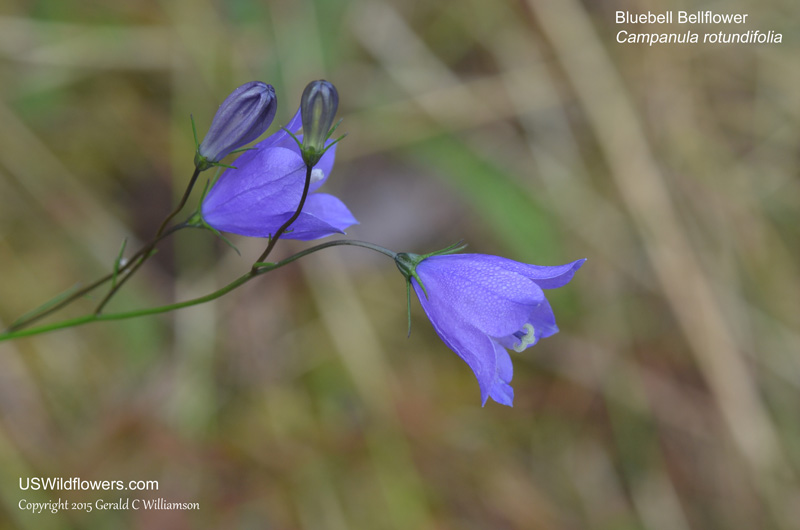
| | Site: Baie Fine of Lake Huron, Ontario, Canada Date: 2015-August-13 | Photographer: Gerald C Williamson
Nikon D7000 | | Campanula rotundifolia has 5 stamens deep within the bell-shaped corolla, and a 3-lobed stigma. | | Click on the photo for a larger image
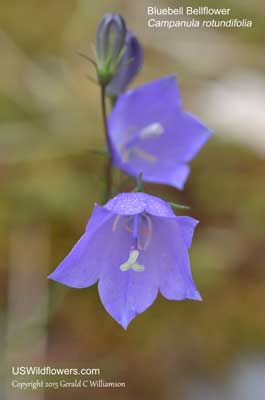
| | Site: Memorial Falls Trailhead, Neihart, MT Date: 2019-July-23 | Photographer: Amanda Cleveland | | Amanda Cleveland found this rare white Bluebell Bellflower at the Memorial Falls Trailhead in Neihart, MT. Photograph dedicated to the daughter she lost many years ago, for whom Amanda has chosen the Bluebell as a symbol. | | Click on the photo for a larger image
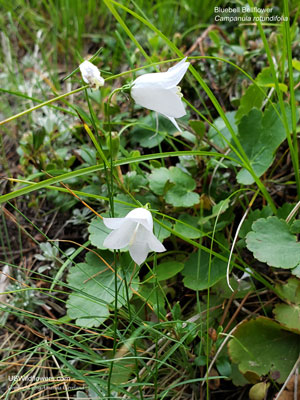
| | Site: Baie Fine of Lake Huron, Ontario, Canada Date: 2015-August-13 | Photographer: Gerald C Williamson
Nikon D7000 | | Bluebell Bellflower blooms in the summer and fall. The calyx lobes are linear. I have read reports that the corolla lobes are reflexed, although in my limited experience they seem to be minimally so if at all, unlike those of Southern Harebell - Campanula divaricata | | Click on the photo for a larger image
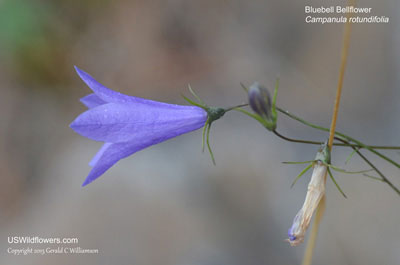
| | Site: Rocky Mountain National Park, Larimer County, CO Date: 2016-August-26 | Photographer: Gerald C Williamson
Nikon D7000 | | In the Rocky Mountains, Campanula rotundifolia can be easily mistaken for Campanula parreyi. The shape of the basal leaves are different, but those of C. rotundifolia will be withered by bloom time. The linear sepals of C. parryi will reach the cleft in the corolla lobes, while those of C. rotundifolia are much shorter. | | Click on the photo for a larger image
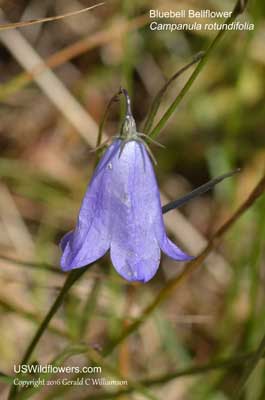
| | Site: Baie Fine of Lake Huron, Ontario, Canada Date: 2015-August-13 | Photographer: Gerald C Williamson
Nikon D7000 | | Campanula rotundifolia grows to about 15 inches high. It has a weak stem, although not as weak as some of the sprawling members of the genus, causing it to frequently lean over notably when bearing the weight of its blossoms, although it will be more frequently erect. The stem is terete - rounded, or nearly so, and may or may not branch. The stem leaves are linear. The basal leaves, which usually wither by flowering, are rounded, yielding the species epithet. | | Click on the photo for a larger image
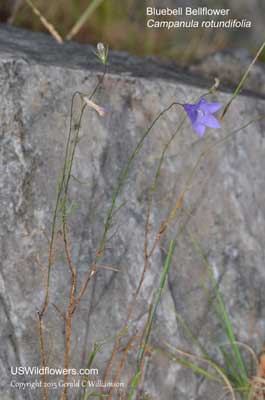
|
References used for identification and information:
|
|
| |
| #ad
|
|








